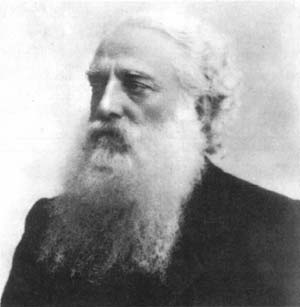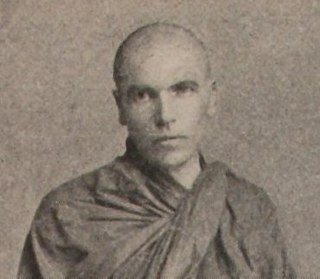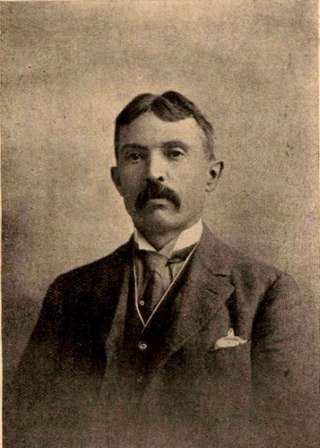Related Research Articles

Colonel Henry Steel Olcott was an American military officer, journalist, lawyer, Freemason and the co-founder and first president of the Theosophical Society.

The Bodhi Tree, also called the Mahabodhi Tree or Bo Tree, is a large sacred fig tree located in Bodh Gaya, Bihar, India. Siddhartha Gautama, the spiritual teacher who became known as the Buddha, is said to have attained enlightenment or buddhahood circa 500 BCE under this tree. In religious iconography, the Bodhi Tree is recognizable by its heart-shaped leaves, which are usually prominently displayed.

Anagārika Dharmapāla was a Sri Lankan Buddhist revivalist and a writer.

Travers Christmas Humphreys, QC was a British jurist who prosecuted several controversial cases in the 1940s and 1950s, and who later became a judge at the Old Bailey. He also wrote a number of works on Mahayana Buddhism and in his day was the best-known British convert to Buddhism. In 1924 he founded what became the London Buddhist Society, which was to have a seminal influence on the growth of the Buddhist tradition in Britain. His former home in St John's Wood, London, is now a Buddhist temple. He was an enthusiastic proponent of the Oxfordian theory of Shakespeare authorship.

Saṅghamittā was an Indian Buddhist nun and believed to be the eldest daughter of Emperor Ashoka from his first wife and Empress, Devi. Together with her brother Mahinda, she entered an order of Buddhist monks. The two siblings later went to Sri Lanka to spread the teachings of Buddha at the request of King Devanampiya Tissa who was a contemporary of Ashoka. Ashoka was initially reluctant to send his daughter on an overseas mission. However, because of the insistence of Sangamitta herself, he finally agreed. She was sent to Sri Lanka together with several other nuns to start the nun-lineage of Bhikkhunis at the request of King Tissa to ordain queen Anulā and other women of Tissa's court at Anuradhapura who desired to be ordained as nuns after Mahinda converted them to Buddhism.

Theravada Buddhism is the largest and official religion of Sri Lanka, practiced by 70.2% of the population as of 2012. Practitioners of Sri Lankan Buddhism can be found amongst the majority Sinhalese population as well as among the minority ethnic groups. Sri Lankan Buddhists share many similarities with Southeast Asian Buddhists, specifically Myanmar Buddhists and Thai Buddhists due to traditional and cultural exchange. Sri Lanka is one of five nations with a Theravada Buddhist majority.

Anagarika Govinda was the founder of the order of the Arya Maitreya Mandala and an expositor of Tibetan Buddhism, Abhidharma, and Buddhist meditation as well as other aspects of Buddhism. He was also a painter and poet.

The Sri Lankan independence movement was a peaceful political movement which was aimed at achieving independence and self-rule for the country of Sri Lanka, then British Ceylon, from the British Empire. The switch of powers was generally known as peaceful transfer of power from the British administration to Ceylon representatives, a phrase that implies considerable continuity with a colonial era that lasted 400 years. It was initiated around the turn of the 20th century and led mostly by the educated middle class. It succeeded when, on 4 February 1948, Ceylon was granted independence as the Dominion of Ceylon. Dominion status within the British Commonwealth was retained for the next 24 years until 22 May 1972 when it became a republic and was renamed the Democratic Socialist Republic of Sri Lanka.

Theosophical teachings have borrowed some concepts and terms from Buddhism. Some theosophists like Helena Blavatsky, Helena Roerich and Henry Steel Olcott also became Buddhists. Henry Steel Olcott helped shape the design of the Buddhist flag. Tibetan Buddhism was popularised in the West at first mainly by Theosophists including Evans-Wentz and Alexandra David-Neel.

Sri Lanka is officially a Buddhist country, while Sri Lankans practice a variety of religions. As of the 2012 census, 70.2% of Sri Lankans were Buddhists, 12.6% were Hindus, 9.7% were Muslims, 7.4% were Christians. Buddhism is declared as the State religion of Sri Lanka and has been given special privileges in the Sri Lankan constitution such as the government is bound for protection and fostering of Buddhist Dharma throughout the nation. However, the constitution also provides for freedom of religion and right to equality among all its citizens. In 2008 Sri Lanka was the third most religious country in the world according to a Gallup poll, with 99% of Sri Lankans saying religion is an important part of their daily life.
Dharmapala is a Sanskrit name which means "protector of the Dharma". The Pāli equivalent is Dhammapala. The name is often used by Buddhists to refer to a variety of persons and concepts, including:
Mahinda College is a Buddhist boys' school in Galle, Sri Lanka. The school was established on 1 March 1892 by the Buddhist Theosophical Society led by Colonel Henry Steel Olcott. As of today it is a national school which provides primary and secondary education across 13 grades to a student population of over 4000.

Buddhism in the United Kingdom is the fifth-largest religious group in the United Kingdom. The 2021 United Kingdom census recorded just under 290,000 Buddhists, or about 0.4% of the total population, with the largest number of Buddhists residing in Greater London and South East England. According to a Buddhist organisation, the growth of Buddhism in the United Kingdom is mainly a result of conversions.
Buddhism in England has growing support. 238,626 people in England declared themselves to be Buddhist at the 2011 Census and 34% of them lived in London.

Musaeus College is a Buddhist private girls' school in Colombo, Sri Lanka. The school is named after its founding principal, Marie Musaeus Higgins from Wismar, Germany, who served as the school's principal from 1891 to 1926. Musaeus College provides primary and secondary education to more than 6,500 girls from ages 3 to 18, and is managed by a board of trustees. The school's motto is "Follow the Light".
Dharmapala or Dom João Dharmapala Peria Bandara was the last king of the Kingdom of Kotte, in present-day Sri Lanka, from 1551 until 27 May 1597. He is also known as Dom João Dharmapala, the first Christian king in Sri Lankan history. He is widely despised by the majority of Buddhist Sinhalese for having betrayed his religion of birth i.e., Buddhism and converting to the religion of the foreign conquerors, who carried a reign of terror. Dharmapala allowed Buddhist Temples in his Kingdom, including the highly venerated Temple of Kelaniya to be ransacked and burnt down by the Portuguese.

U Dhammaloka was an Irish-born migrant worker turned Buddhist monk, strong critic of Christian missionaries, and temperance campaigner who took an active role in the Asian Buddhist revival around the turn of the twentieth century.

Myron Henry Phelps was a New York lawyer and religious writer. He was known for his interest in Buddhism, and studied and wrote about the Baháʼí Faith and the Radha Soami movement. He traveled to eastern Asia and supported the India House in Manhattan.

Mary Elizabeth Mikahala Robinson Foster was a Hawaiian philanthropist and known as the first Hawaiian Buddhist. On her death, she donated her substantial gardens to the city of Honolulu, and they later became the Foster Botanical Garden.

Devapriya Valisinha was a Sri Lankan Buddhist revivalist who served as the 2nd President of the Maha Bodhi Society for thirty-five years, from the death of his mentor Anagarika Dharmapala in 1933 until his own death in 1968.
References
- ↑ Thomas A. Tweed The American Encounter with Buddhism: 1844 - 1912 1992 Page 87 "21 Canavarro transgressed the boundaries of Victorian social norms even more clearly and forcefully, however, when she began her secret "spiritual marriage" to Myron Henry Phelps (1856-1916), the Buddhist sympathizer, New York attorney"
- ↑ John Holt. The Sri Lanka Reader: History, Culture, Politics, 2011, p. 367. Quote: "Countess Miranda de Souza Carnavarro, briefly known as Sanghamitta, was an American theosophist and wealthy socialite who converted to Buddhism in 1897 under the discipleship of the Anagarika Dharmapala. Under Dharmapala's ..."
- 1 2 Bartholomeusz, Tessa (1994). "Real Life and Romance: The Life of Miranda de Souza Canavarro". Journal of Feminist Studies in Religion. 10 (2): 27-47.